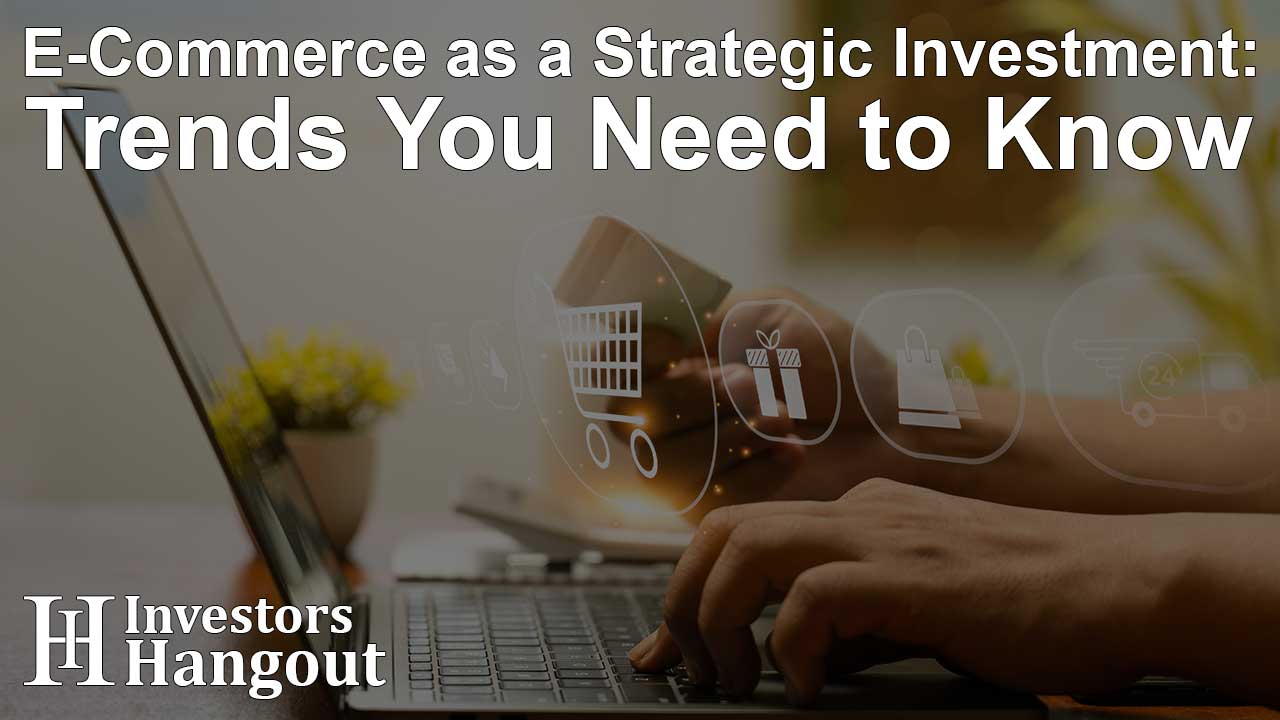E-Commerce as a Strategic Investment: Trends You Need to Know

There was a time when eCommerce was just... a sales tool. Something extra you built to keep up with everyone else. Now it’s something entirely different. For investors and founders alike, eCommerce has become the heart of how modern companies grow, gather data, and build long-term value.
If you’re thinking of scaling seriously, partnering with an all services Ecommerce agency can help you make that shift. But before we rush into strategies and tech stacks, let’s pause for a second and look at what’s really happening behind the scenes. Why has eCommerce turned from “nice to have” into a real strategic investment? And what should you keep an eye on next?
eCommerce stopped being just about selling things
It’s not only about getting people to click “buy” anymore. It’s about building something that lives and grows over time — a network of loyal customers, solid systems, and smart data loops that keep working even when you’re not looking.
Each sale feeds a system. Each returning customer adds to the foundation. Over time, that becomes more than revenue — it’s infrastructure. And the brands that understand this are the ones investors quietly pay attention to.
When your digital operations are connected, when your logistics, marketing, and support all speak the same language, you stop relying on luck or seasonal demand. You start compounding value. That’s where eCommerce turns from a department into an asset.
The shift: from store to capital
Think about this for a second. A physical store has walls, shelves, and limited space. An eCommerce ecosystem doesn’t. Every improvement — automation, personalization, fulfillment speed — makes the whole structure stronger.
When you treat digital commerce like capital, you build layers that last. You stop chasing quick wins and start stacking long-term advantages: cleaner data, lower customer acquisition costs, higher lifetime value.
And yes, this takes time. But unlike ads that vanish the moment you stop paying, these systems keep paying back long after the first setup.
The big trends shaping eCommerce right now
Let’s get into the real stuff. The trends that aren’t just buzzwords but actual signals of where the smart money is going.
1. Headless commerce and flexibility
If your online store feels like a heavy box you can’t move without breaking something, you’re not alone. That’s why headless architecture — separating the front end from the back end — has become such a game changer.
It lets brands experiment, customize, and scale without rebuilding everything from scratch. Investors like that too. It reduces technical risk and keeps businesses adaptable when markets shift.
2. The rise of true omnichannel
The average customer moves across three or four touchpoints before buying. They see a product on social media, read reviews online, walk into a store, then finally order through their phone.
Omnichannel isn’t a buzzword anymore; it’s basic survival. The trick is to make that journey feel seamless, not like jumping between disconnected systems.
For investors, that’s gold — because when everything syncs, costs drop and loyalty rises. It’s operational intelligence dressed as convenience.
3. Data that actually means something
Let’s be honest: most brands drown in data but don’t really use it. The smart ones focus on first-party data — what customers willingly share through their interactions.
This kind of data fuels personalization that actually feels human. Not “you viewed this, so here’s the same thing again,” but “we understand what you might want next.”
The financial upside? Higher retention, better margins, and far less dependency on ads. It’s like moving from renting your audience to owning it.
4. Subscriptions and predictable growth
Subscriptions used to mean magazines. Now they mean stability.
From coffee to cosmetics, subscription models give brands breathing room — predictable revenue, repeat customers, easier forecasting. And customers get convenience.
Investors love predictability. It smooths the peaks and valleys. It turns chaotic sales cycles into calm, measured progress.
5. Owning your platform
Here’s something that doesn’t get said enough: building your own eCommerce ecosystem — or even a small marketplace — changes the game completely.
Instead of fighting for visibility on someone else’s turf, you create your own environment. You control the rules, the data, and the customer experience.
Sure, it’s harder. But when it works, you’re not just selling products anymore — you’re operating a platform. That’s a different league of value.
6. Social commerce is the new storefront
People don’t “go shopping” online anymore. They stumble upon something while scrolling. The line between content and commerce is paper-thin.
Livestream shopping, creator-led drops, shoppable videos — they’re not side trends; they’re the new normal.
The key is keeping control of your audience. Social media gives reach, but your website keeps the relationship. Use one to feed the other, not replace it.
7. Conscious consumption
This one feels less like a trend and more like a shift in mindset. Shoppers care where things come from. They care who made them, and how.
Transparency, sustainability, circular models — these aren’t just PR moves. They influence how investors and customers alike judge long-term potential.
A business that can grow without burning out people or the planet tends to hold its value better. It’s that simple.
Behind the curtain: where the smart money actually goes
Let’s zoom in a bit. Beyond shiny design or fancy ads, the real power of eCommerce lies in the boring stuff. The systems. The quiet optimizations that quietly add margin without drama.
Fulfillment that feels invisible
People expect fast delivery. They don’t care how it happens. But when it doesn’t — they remember.
Brands investing in better logistics, real-time tracking, and regional hubs don’t just make customers happier. They make their margins healthier. Each step saved, each return avoided, adds up.
Checkout that doesn’t get in the way
A smooth checkout is still one of the highest ROI investments you can make.
Every unnecessary field or lagging page chips away at conversion. Remove friction, and watch your sales grow — not because of a viral post, but because the process finally makes sense.
Support that actually helps
Automation’s great until it isn’t. When something goes wrong, real people still matter.
Investing in trained, data-backed support teams creates long-term trust. It’s not just about fixing issues — it’s about showing customers you actually care enough to solve them properly.
Retention grows quietly in those moments.
Thinking like an investor, not just a seller
If you want to treat your eCommerce operation as an asset, measure it like one.
Go beyond surface metrics. Yes, traffic and conversion matter, but investors care about things that show durability:
-
Customer lifetime value
-
Customer acquisition cost
-
Retention rates
-
Average order value
-
Contribution margin
Those numbers tell the story of a business that can scale sustainably — not one that burns bright and fades fast.
The compounding effect
Here’s something people overlook: every small improvement compounds.
Faster fulfillment means happier customers, which means better reviews, which means cheaper acquisition. That’s a loop.
Improve your return rate, and you improve cash flow. Personalize better, and you lower churn. It’s all connected. Small, steady optimizations stack up faster than one big viral win.
Scaling the smart way
If you’re building an eCommerce brand today, it’s tempting to chase every trend. New tech, new ads, new channels. But the smartest founders do something different. They move slow where it matters.
They fix the basics first:
-
Seamless user experience.
-
Reliable fulfillment.
-
Data that’s actually useful.
-
Automation that doesn’t break the human touch.
Only after that do they think about expansion — subscriptions, marketplaces, new regions. That’s the part that turns steady growth into long-term equity.
The traps to avoid
A few things can quietly derail even the most promising eCommerce idea.
-
Overcomplicating early. Keep tech lean until you know what really works.
-
Locking into bad vendors. Flexibility beats loyalty in this space.
-
Ignoring compliance. Data laws get stricter every year; stay ahead of them.
-
Relying too much on ads. Paid traffic is great, but dependency kills margin.
Balance ambition with restraint. Build what compounds, not what drains.
What investors really look for
If you ever plan to raise money or sell your brand, it helps to know what serious investors check first.
They look for predictable revenue, clean data, and a system that doesn’t collapse if one channel fails. They look for efficiency — fewer moving parts doing more.
And, most importantly, they look for proof that customers actually like what you’re selling enough to come back without being bribed by discounts.
That’s the quiet test every business eventually faces.
On the horizon
Zoom out for a moment. eCommerce isn’t just part of the economy anymore — it’s becoming the economy’s language. The way brands talk to their customers, collect insights, and grow sustainably.
It’s not going anywhere. If anything, it’s getting deeper into how businesses operate, from finance to logistics to brand building.
The question isn’t whether to invest in eCommerce — it’s how intentionally you do it.
The takeaway
Treat eCommerce like a living system. Something that evolves, learns, and compounds.
Invest in tools, sure. But more than that — invest in clarity, in data that tells the truth, in customer experiences that feel real.
If you do that, you’re not chasing trends anymore. You’re building the kind of business that lasts.
And in a world that moves this fast, that might be the most strategic investment of all.
About The Author
Contact Hannah Lewis privately here. Or send an email with ATTN: Hannah Lewis as the subject to contact@investorshangout.com.
About Investors Hangout
Investors Hangout is a leading online stock forum for financial discussion and learning, offering a wide range of free tools and resources. It draws in traders of all levels, who exchange market knowledge, investigate trading tactics, and keep an eye on industry developments in real time. Featuring financial articles, stock message boards, quotes, charts, company profiles, and live news updates. Through cooperative learning and a wealth of informational resources, it helps users from novices creating their first portfolios to experts honing their techniques. Join Investors Hangout today: https://investorshangout.com/
